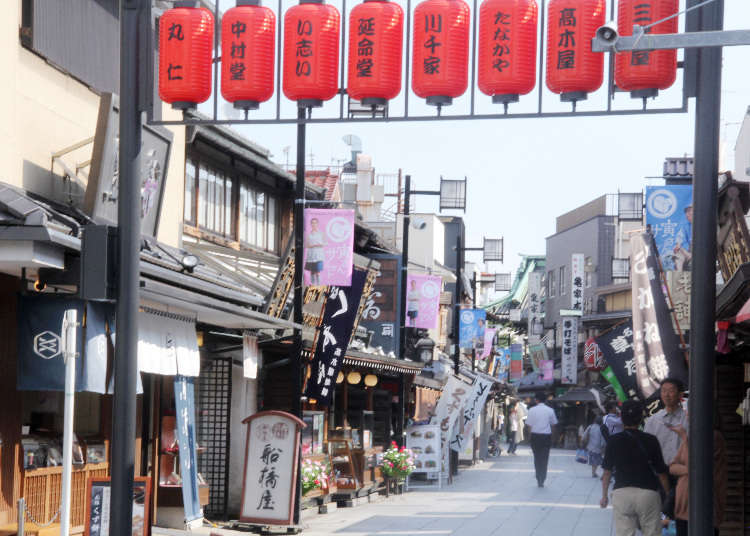
Among Tokyoites, Shibamata is known as the city’s most nostalgic neighborhood, a place with a warm atmosphere that lets you forget the hustle and bustle of the metropolis for a while. It’s a “shitamachi,” one of Tokyo’s old towns that still bear a close resemblance to Edo, one that has a special place in the heart of many a Japanese person. The long-running TV film series “Otoko wa Tsurai Yo,” or it’s tough being a man, was filmed here as the main protagonist’s much-beloved home. The center of the neighborhood is dominated by the magnificent Shibamata Taishakuten, a Buddhist temple founded in 1629. Beautiful sculptures and a calm Japanese garden invite to a leisurely sightseeing stroll.
The approach to the temple is a scenic street – a lot livelier than the tranquil temple - dotted with numerous shops, stalls, and restaurants, selling delicacies typical for the area such as una-ju (eel on rice in a lacquered box), kusa dango (mugwort dumplings), and senbei (rice crackers). Located in Tokyo’s northeast, Shibamata is a mere 30-minute train ride away from popular Asakusa, offering an entirely different taste of Tokyo’s old days.
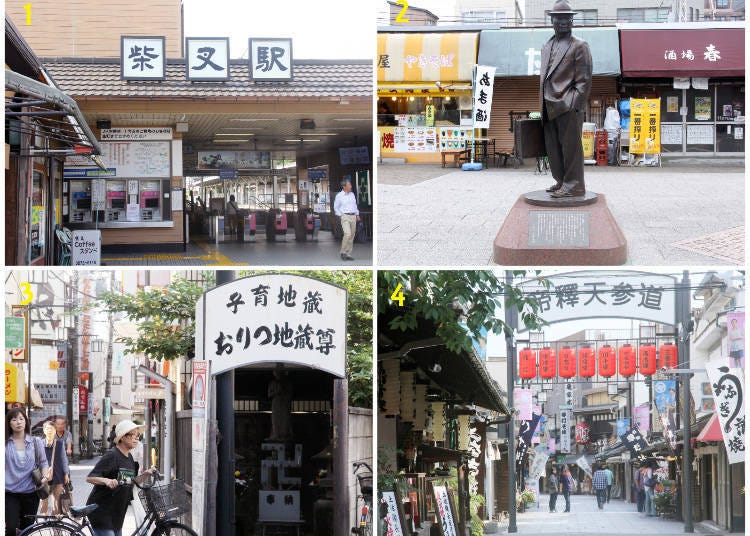
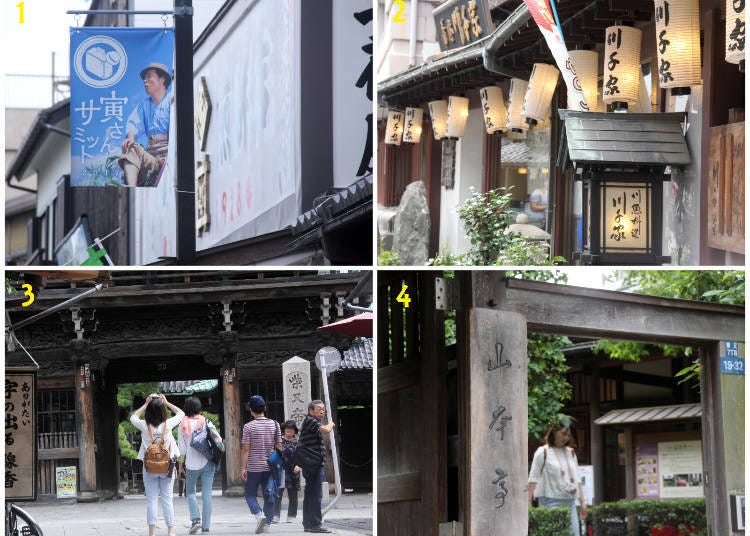
Eating Shibamata’s Signature Dish at “Ebisuya”

The street that acts as the approach to Shibamata Taishakuten is home to many well-established restaurants selling the area’s specialty, una-ju. Behind this name hides a delicious eel dish of grilled eel served on rice in a lacquered box.
We especially recommend a shop called Ebisuya. This freshwater fish specialty restaurant boasts a history of over 230 years. It can be found near the entrance of the street, housed in a scenic wooden building that seems like a remnant of a lost century. The slightly raised seats overlook a beautiful garden, providing a unique, authentically Japanese atmosphere.
Of course, you have to order the famous una-ju. The charcoal-grilled eel is of exquisite taste and thinly coated in a secret sauce – one bite and you’ll understand why this dish is so popular. Another warm recommendation is a set called “kawasakana gozen” for 2,250 yen. Literally translating to freshwater fish meal, this set lets you try a variety of dishes, including “koi no arai,” carp sashimi, rice with eel called “unagi-iri gohan,” carps simmered in miso called “koikoku,” and dumplings as dessert. If you don’t want to get too experimental, stick with the “Shibamata gozen” for 1,995 yen, serving you tempura and sashimi.
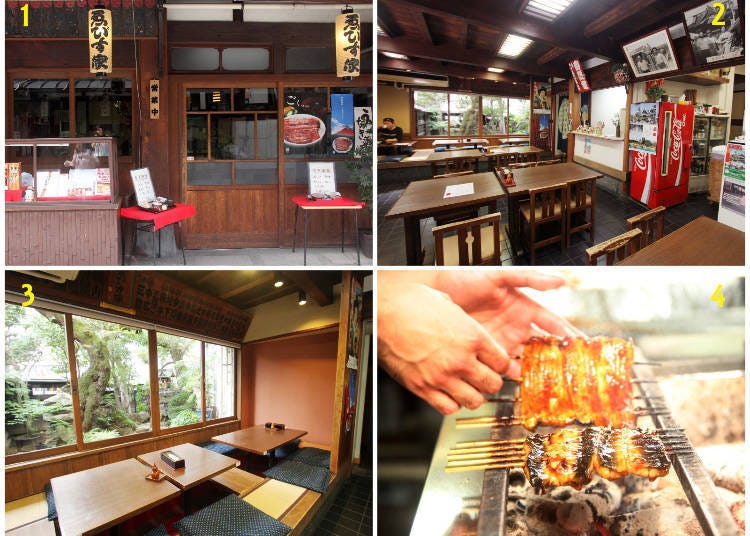
Hours: 11:00 a.m. – 7:00 p.m. (last order)
Closed: irregularly (four times a month)
Access: Shibamata Station (Keisei Kanamachi Line), 1 minute on foot
-
Ebisuyaゑびす家
- Address 7-3-7 Shibamata, Katsushika-ku, Tokyo, 125-0052
- Phone Number 03-3657-2525
Takagiya Shinise’s Delicious Dumplings
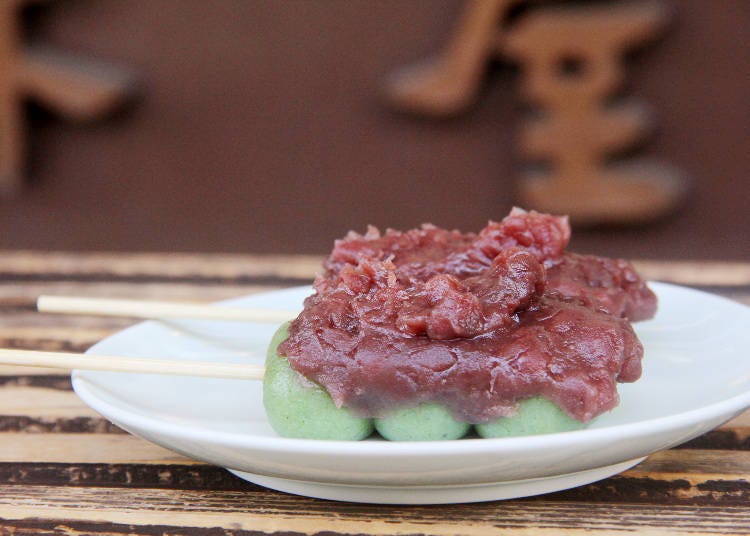
Shibamata isn’t just famous for eel dishes, it’s also well-known for kusa dango, or mugwort dumplings. A long time ago, Shibamata had a thriving rice cultivation and the farmers mixed the rice with homegrown mugwort to serve kusa dango to visitors and worshipers of Taishakuten temple. Following that, the neighborhood has become famous for the delicious green dumplings.
One store where you get to savor this casual delicacy is Takagiya Shinise, a shop that also served as the set of Otoko wa Tsurai yo. It has served as the model of the dumpling shop that is the home of the main character, Tora-san. The shop is actually two building standing opposite of each other. The Takagiya Shinise on the right side (facing the temple) of the street sells dumplings, while the left-side shop will tickle your taste buds with Japanese-style sweets and meals. Next to the classic kusa dango, topped with plenty of coarse, sweet bean paste, we urge you to try the “yakidango,” or grilled dumpling, available for 160 yen per skewer. For an extravagant combination of flavors, try the “shoyu dango” for the same price, coated in soy sauce and sprinkled with dry seaweed.
Takagiya Shinise also offers Shibamata-style souvenirs, such as the “Shibamata mochi” (rice cakes) in a box of five for 850 yen. They’re also infused with mugwort and will surprise you with a sweet filling of red bean paste on the inside.
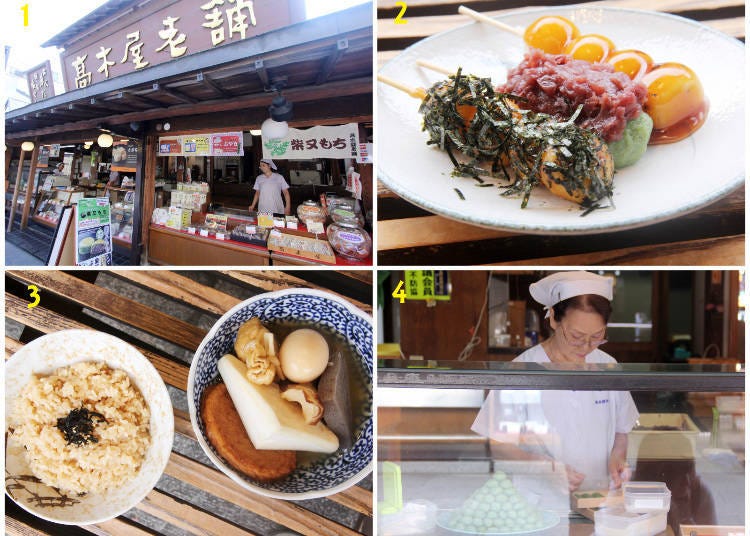
Hours: 7:00 a.m. – 5:30 p.m.
Closed: always open
Access: Shibamata Station (Keisei Kanamachi Line), 2 minutes on foot
-
Takagiya Shinise高木屋老舗
- Address 7-7-4 Shibamata, Katsushika-ku, Tokyo, 125-0052
- Phone Number 03-3657-3136
Yamatoya: Serving Nostalgic Tempura That'll Leave You Craving for More
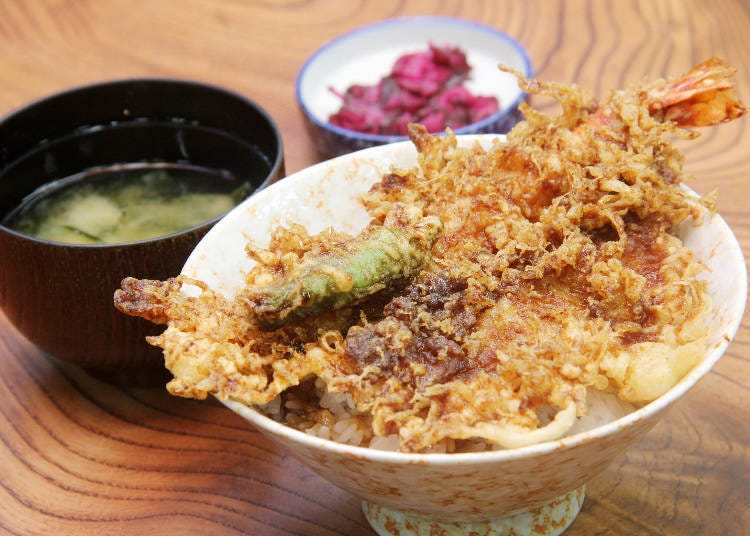
Next up: tempura! For that, we head to Yamatoya, a restaurant that the actor who played Tora-san of Otoko wa Tsurai yo is said to have absolutely loved. The homemade tempura served here is all about crunchily fried shrimp and vegetables, topped with plenty of sweet-and-sour sauce! Fans of Yamatoya’s ten-don (tempura bowl) swear by the wonderfully nostalgic taste that hasn’t changed since the 150 years of the restaurant’s opening. Back then, Yamatoya was mainly selling cakes and sweets, and even today, you can get the Shibamata specialty of kusadango as a souvenir, one box for 600 yen. Next to the tempura bowl, also try classic tempura for 1,620 yen (regular) or oden for 540 yen – Yamatoya serves various authentic Japanese dishes, one better than the other!
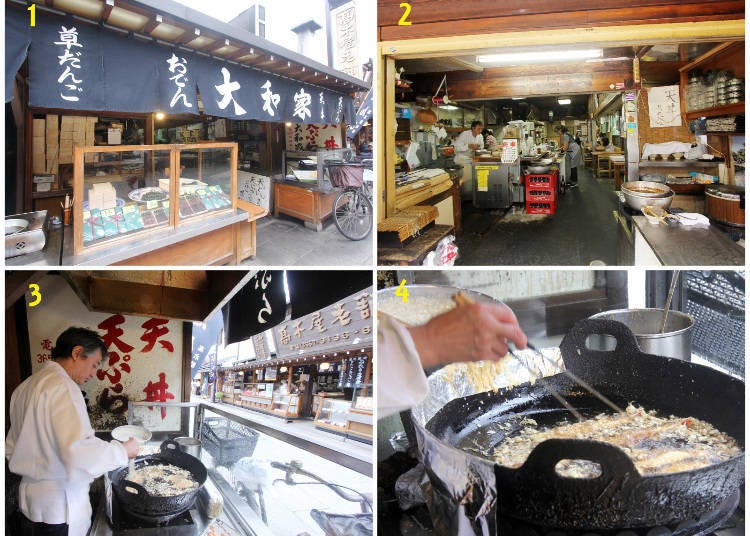
Hours: 9:00 a.m. – 5:00 p.m. (food service from 11:00 a.m. – 4:00 p.m.)
Closed: irregularly
Access: Shibamata Station (Keisei Kanamachi Line), 2 minutes on foot
-
Yamatoya大和家
- Address 7-7-4 Shibamata, Katsushika-ku, Tokyo, 125-0052
- Phone Number 03-3657-6492
Ishii – The Fluffiest Cake Roll in all of Shibamata!
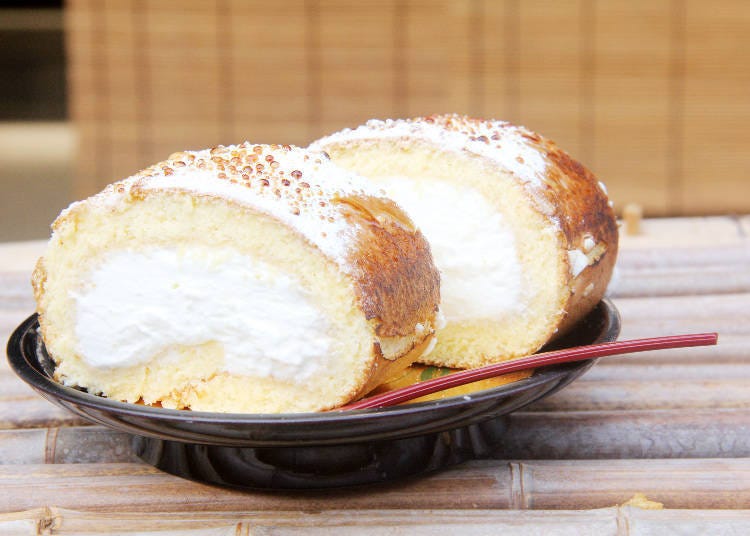
The old, wooden building just before Taishakuten will catch your eye immediately – that’s Ishii. This shop is famous for its sweets and pickles, with a delicacy called “Kome Kome Cake Roll” being by far the most popular after it was showcased on Japanese TV. Filled with plenty of cream, the cake is of an unbelievably fluffy texture while maintaining a rather crunchy crust, highlighted with toasted caramel and powdered wasanbon sugar.
Apart from this heavenly cake, look forward to trying a variety of other delights, such as the “Shibamata Éclair,” mellow custard cream inside crunchily baked pie dough and sesame sprinkles for 190 yen. We also love the “Futen no Dorayaki” for 190 yen, as well as the various pickles sold for about 50 yen each.

Hours: 8:30 a.m. – 5:00 p.m.
Closed: irregularly
Access: Shibamata Station (Keisei Kanamachi Line), 3 minutes on foot
-
Ishiiい志い
- Address 7-6-20 Shibamata, Katsushika-ku, Tokyo, 125-0052
- Phone Number 03-3657-1749
The Delicious Crunch of Asanoya Senbeiten’s Rice Crackers
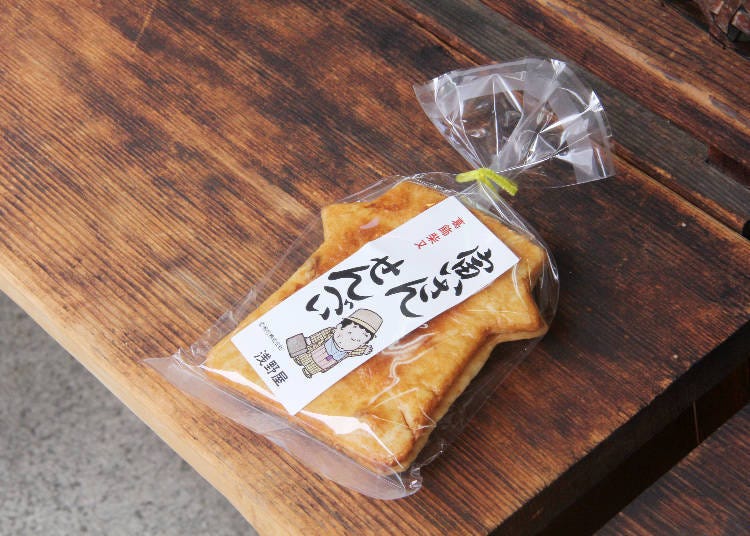
As an area with a thriving rice cultivation, Shibamata has a long history of making excellent senbei (rice crackers). On the approach to Taishakuten, you’ll find numerous shops and stalls offering the crunchy delicacy, but our special recommendation is a store called Asanoya Senbeiten. Even today, Asanoya sticks to the old practice of “robata-yaki,” meaning grilling the rice crackers right at the shop over hot charcoal. For the senbei, the shop uses a rice variety called koshihikari from Ibaraki Prefecture, doing every step of the process in-house, even the milling. Asanoya offers the rare opportunity of watching the staff make a rice cracker from start to finish!
Coated with soy sauce and then grilled, the rice crackers have a wonderfully traditional taste, and we urge you to try the “isomaki” with dried seaweed for 70 yen per cracker, the “zarame” with coarse sugar for 70 yen, and the fragrant “katayaki” for 55 yen - in total, Asanoya offers 10 different kinds of rice crackers! Because they’re sold as single senbei, they’re the perfect snack to nibble on while exploring the area.
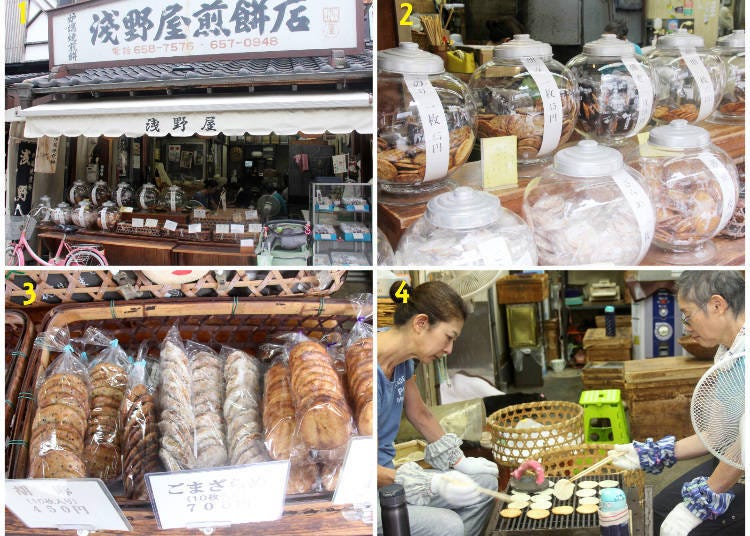
Hours: 9:00 a.m. – 5:00 p.m.
Closed: Mondays (or the following day should Monday be a national holiday)
Access: Shibamata Station (Keisei Kanamachi Line), 4 minutes on foot
-
Asanoya Senbeiten浅野屋煎餅店
- Address 7-6-18 Shibamata, Katsushika-ku, Tokyo, 125-0052
- Phone Number 03-658-7576
Traditional Candy with a Rhythm at Matsuya no Ame
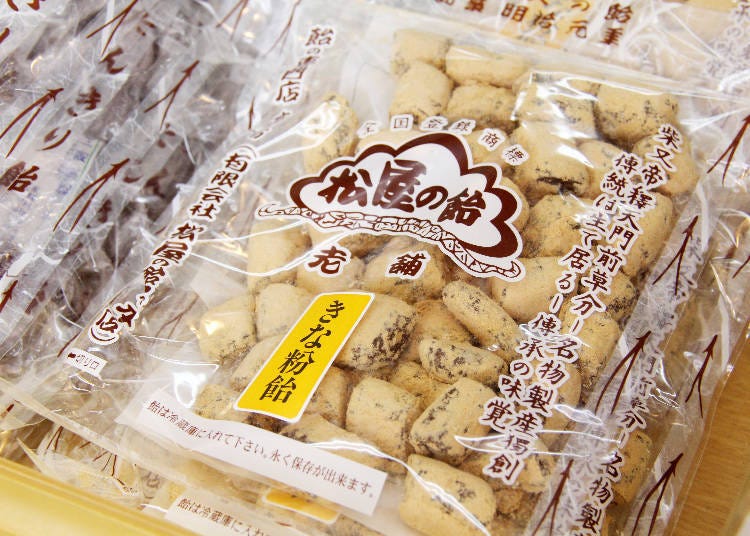
Matsuya no Ame is a candy shop that dates back to 1868. It was originally founded in Fukagawa but moved its business to Taishakuten’s temple approach in Shibamata in 1934. The store sells a variety of traditional candy specialties, including many Japanese-style flavors and even herbs, such as mugwort, Chinese bellflower, and ginger. Especially popular since many decades is the “sekitome ame,” a candy that promises relief from coughing. For an authentically Japanese taste, opt for “sarashi ame,” a glutinous rice candy that is of a gentle sweetness, “anko ame” with a drop of sweet red bean paste inside, or “kinako ame,” a candy mixed with brown sugar and roasted soy flour. All varieties are packed in 100g bags for 300 – 500 yen.
On Sundays and national holidays, excluding summer, you’ll be able to see the candy masters cut their creations like it has been done since the shop’s founding. The quick knives produce a catchy rhythm. Over a hundred years ago, this rhythm caught the attention of temple visitors and encouraged them to try some candy, a fun strategy that is effective even today! Watching and listening to the harmonious beat of the candy makers and their knives is so mesmerizing, the government of Japan has made this scenery one of the 100 soundscapes of Japan.
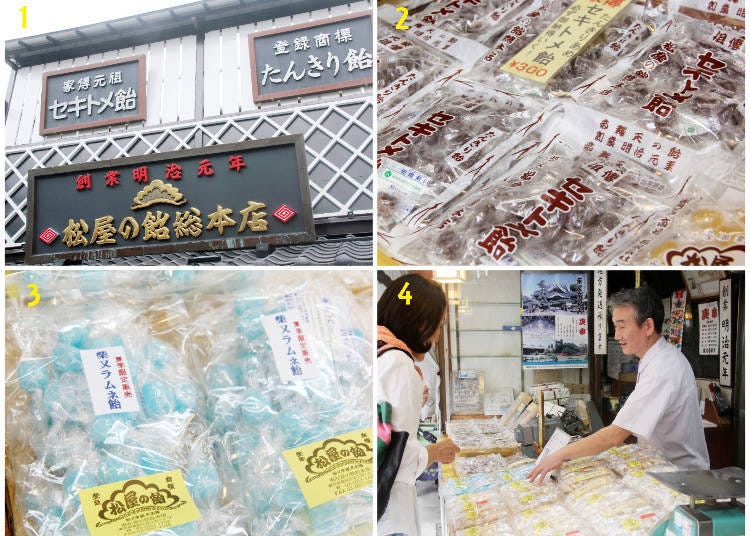
Hours: 8:30 a.m. – 5:00 p.m.
Closed: irregularly
Access: Shibamata Station (Keisei Kanamachi Line), 4 minutes on foot
-
Matsuya no Ame Souhonten松屋の飴総本店
- Address 7-6-17 Shibamata, Katsushika-ku, Tokyo, 125-0052
- Phone Number 03-3657-1739
The Secrets of Taishakuten Temple: Pines like Dragons and Beautiful Wood Carvings

Shibamata Taishakuten is an old temple of the Buddhist Nichiren sect, founded in 1629. The temple became a popular destination for worshipers since the end of the 18th century when a Taishakuten-boom swept through Japan – Taishakuten is an important Buddhist deity, also known as Indra or Śakra. Since then, the temple is known as “Shibamata Taishakuten” rather than by its actual name of Daikyoji Temple.
The end of the temple approach is marked by the majestic Nitenmon gate, with a hall enshrining Taishakuten called Taishaku-do just behind. On the right side, you’ll find the main hall of the temple, Soshi-do. The absolute highlight of the temple grounds is the breathtakingly beautiful wooden carvings adorning the walls of the halls. They act as a prayer wall depicting the Lotus Sutra, one of the most important Buddhist texts, in an immersive 3D carving style. While the carvings are protected behind glass, an admission of 400 yen will grant you entry to the sculpture gallery leading all around the walls – that price is well worth the experience. Studying the delicate works from up close will reveal many a hidden secret, such as the filigree tea set at the Buddha’s feet, and grant a glimpse into the beauty of Buddhism, whether you’re a follower or not.
A less obvious must-see is the large pine tree towering right before the main hall. This tree boasts a life of over 500 years and is often compared to a dragon because of its long, strong branches.
Make sure to also step around the main hall – an extraordinarily beautiful and tranquil Japanese garden awaits you there, called Suikeien Garden. Calm both body and mind as you stroll around the garden and experience an atmosphere that is entirely different from the lively Edo-style street we’ve just snacked at.
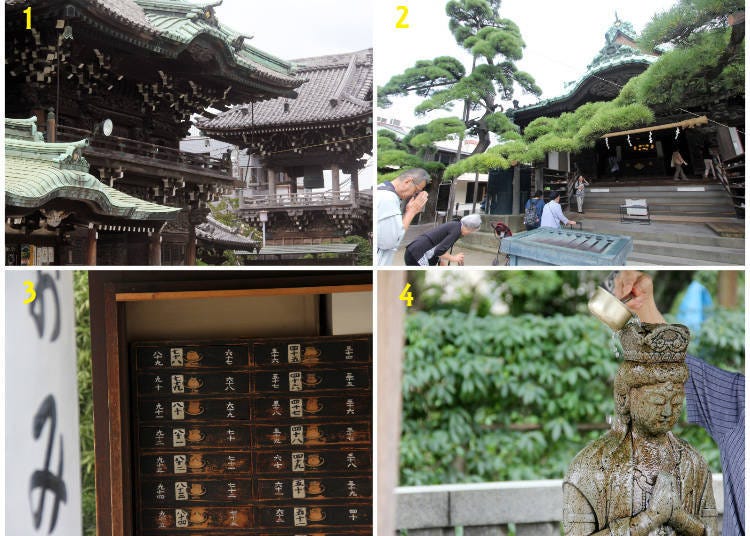
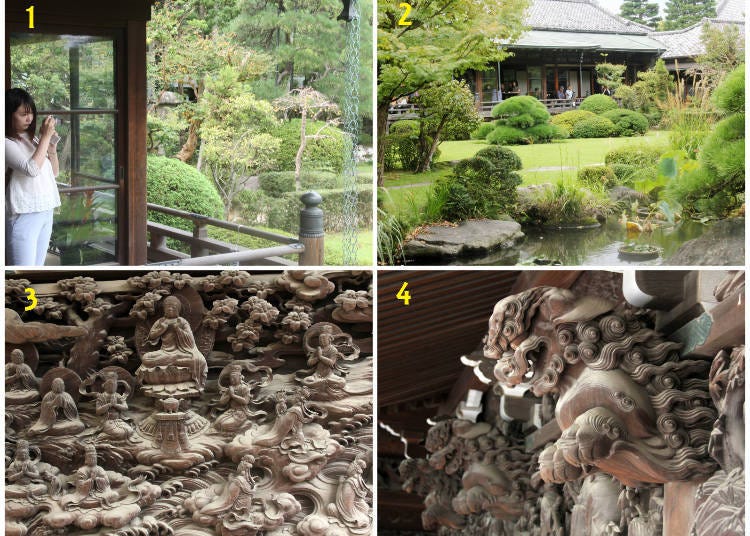
Admission: free worship, garden and gallery: 400 yen
Hours: 9:00 a.m. – 4:00 p.m.
Closed: always open
Access: Shibamata Station (Keisei Kanamachi Line), 5 minutes on foot
-
Shibamata Taishakuten Daikyoji Temple柴又 帝釈天題経寺
- Address 7-10-3 Shibamata, Katsushika-ku, Tokyo, 125-0052
- Phone Number 03-3657-2886
Yamamoto-tei: One of the Most Beautiful Gardens in Japan
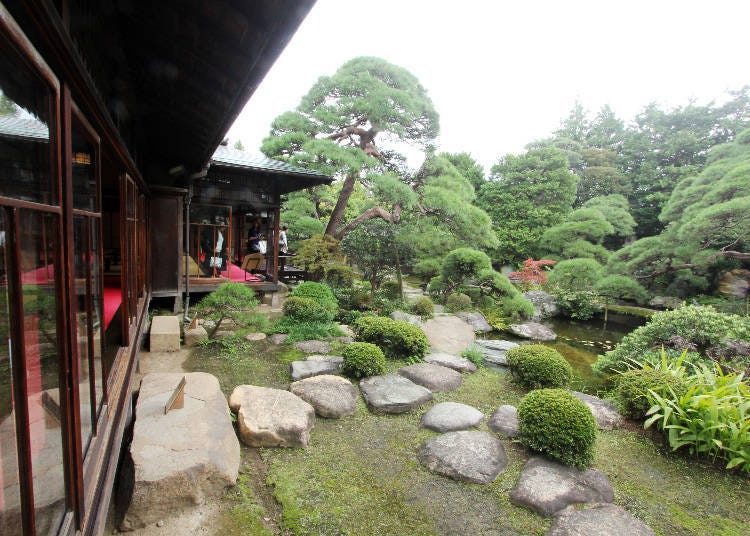
Yamamoto-tei is an astonishingly beautiful building that has once been the residence of Tokyo entrepreneur Einosuke Yamamoto, founder of a camera parts manufacturer. While he originally lived in Asakusa, he moved to Shibamata after the great Kanto Earthquake of 1923 that left large parts of Tokyo devastated.
The characteristic of Yamamoto-tei is the extraordinary blend of Western and traditional Japanese architecture, creating a space that seems to exist harmoniously in between two very different cultures. Especially the adjacent garden is of a particular magnificence. Sukiya Living Magazine, a journal specializing in Japanese gardens from the United States, ranked it among the top 7 among 900 gardens in Japan for 15 consecutive years. In 2016, it even managed to snatch the 3rd rank! The teahouse in the garden provides hot tea and seasonal sweets as you gaze upon the tranquil greenery – it’s the perfect place to leave all your cares behind and allow yourself to be entirely immersed by the beauty of Japan.

1) Nagayamon gate, combining typical Western and Japanese elements 2) the main garden 3) the Drawing Room, the only room in Yamamoto-tei that is entirely inspired by the West 4) enjoy a cup of matcha and Japanese sweets for 600 yen
-
Yamamoto-tei山本亭
- Address 7-19-32 Shibamata, Katsushika-ku, Tokyo, 125-0052
The Tora-san Museum: Travel Back in Time and Explore Otoko wa Tsurai yo’s Nostalgic Shibamata
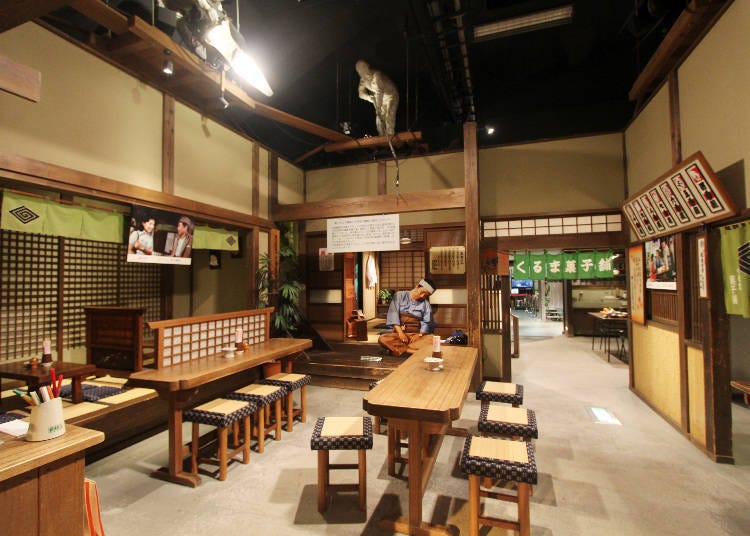
If you come to Shibamata, the Tora-san Museum is an absolute must-visit. As explained earlier, it is all about the film series Otoko wa Tsurai yo that revolves around the wandering salesman Tora-san and his sheer eternal story of his unsuccessful love life. Running between 1969 and 1995, it holds the world record for the world’s longest-running movie series starring a single actor. As such, Otoko wa Tsurai yo and its endearing main protagonist, played by Kiyoshi Atsumi, has a large fandom not only in Japan. The museum itself was opened in 1997.
Even if you have never heard of this show up until now, the Tora-san Museum is well-worth the visit. The dumpling store and print shop of the series have been faithfully recreated, offering not only a nostalgic paradise for fans of Otoko wa Tsurai yo but also a very authentic glimpse into Tokyo’s 60s and 70s.
Other parts of the museum take you even further back: beautiful dioramas show how Shibamata has looked back in the 1930s when Tora-san was a child. There even is a life-sized wagon of a man-powered tramway as it was used decades ago!
For fans of Otoko wa Tsurai yo, we highly recommend also visiting the Yoji Yamada Museum, dedicated to the director of the series and many other movie masterpieces – it’s right next to the Tora-san Museum.
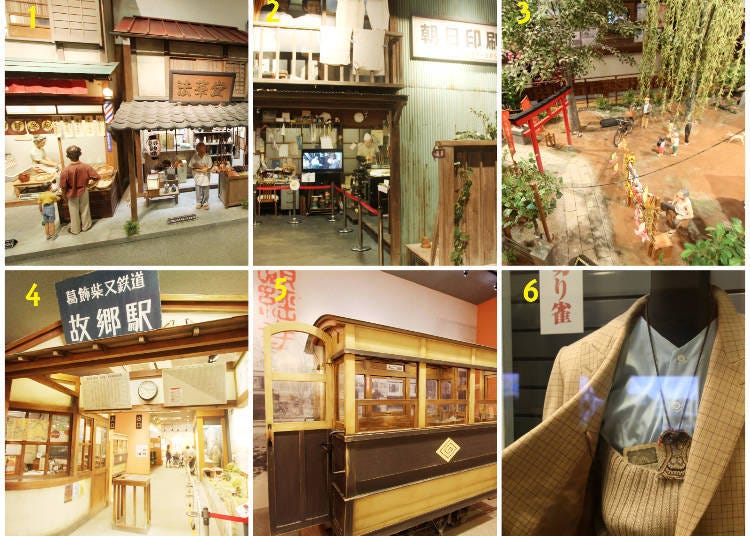
Admission: 500 yen (a combination ticket for Yamamoto-tei and Tora-san Museum is available for 550 yen)
Hours: 9:00 a.m. – 5:00 p.m. (last admission at 4:30 p.m.)
Closed: every 3rd Tuesday of the month, the 3rd Tuesday, Wednesday, and Thursday in December
Access: Shibamata Station (Keisei Kanamachi Line), 8 minutes on foot
-

-
Address
Katsushika-ku, 6-22-19, Shibamata, Katsushika-ku, Tokyo, 125-0052
View Map -
Nearest Station
Shibamata Station (Keisei Kanamachi Line)
8 minutes on foot
- Phone Number 03-3657-3455
-
Address
Katsushika-ku, 6-22-19, Shibamata, Katsushika-ku, Tokyo, 125-0052
Shibamata - A Place Like No Other
Shibamata might be a small neighborhood, but it authentically conveys the lively feeling of Tokyo’s past like no other place could. From retro shops selling local delights that haven’t changed in taste and production since decades to traditional temples and gardens, Shibamata is a treasure trove of discoveries and adventures. Of course, fans of Otoko wa Tsurai yo will have an especially amazing time as they walk the very streets that the show’s endearing hero has done so many times. But even people who don’t have this nostalgic movie connection will find themselves to fall in love with Shibamata – the unique charm of the neighborhood never fails to conquer people’s hearts.
*Prices and options mentioned are subject to change.
*Unless stated otherwise, all prices include tax.
Popular Tours & Activitiess
Recommended places for you
-

How to Get Don Quijote's Exclusive 2025-2026 Winter Gift (+Tax-Free Savings)
-

The Best Japanese Food Representing 2025! 'Dish of the Year®' Annual Award Results Announced
-
Ad

Preserving the Beauty of World Heritage Site Shirakawa-go for the Future Through Responsible Travel
-

[Extended Offer!](12% OFF KKday Coupon) Mt. Fuji Autumn Leaves, Powder Snow & More! 15 Best Tours to Experience Japan in Fall & Winter
-

Enjoy Japan's Gorgeous Winter Lights! Ride the Romancecar to Shonan no Hoseki Illumination
by: Guest Contributor
-

Keisei × Keikyu 16-Temple Goshuin Tour: Discover Deeper Tokyo & Yokohama
by: Guest Contributor
Inspiration for Accommodations
-

Enjoy Mt. Fuji from the Comfort of Your Room! Recommended Ryokan with Mt. Fuji View
-

Stay Near the Cherry Blossoms! Hotels for Cherry Blossom Viewing in Tokyo
-

Family-Friendly Hotels with Free Shuttle to Disneyland: Convenient Access for a Magical Stay
-

Top Ranked Hakone Hotels with Mt. Fuji View: Enjoy Stunning Scenery from Your Private Space
-

Convenient Tokyo Hotels with Airport Shuttle: Ideal for Families and Heavy Luggage
-

Stunning Tokyo Tower View Hotels: Enjoy Spectacular Scenery from Your Private Space
-

Convenient Asakusa Hotels with Kitchens: Ideal for Extended Family Visits
-

Experience Luxury: Hakone's 10 Best Five-Star Accommodations
-

Enjoy Mt. Fuji Autumn Leaves! Top Hotels Near the Popular Autumn Leaves Corridor
-

Experience Hakone Fall Foliage from Your Room with Stunning Views
-

10 Reasons Why We Love 'Shitamachi' - Tokyo's Traditional Downtown Neighborhoods
-

One-Day Walk in Oji and Minowa where Edo Atmosphere Remains
-

Ueno Station Area Guide: Fun Ways to Explore Tokyo's Popular Destination (Area Map & Sightseeing Tips)
-

The Best of Japan: 11 Major Cities Every Traveler Should Visit
-

Explore the Charm of Tsukishima: Tokyo's Hidden Treasure
-

Before Your Flight Home: Tips for Enjoying Your Final Day in Tokyo!
- #best ramen tokyo
- #what to buy in ameyoko
- #what to bring to japan
- #new years in tokyo
- #best izakaya shinjuku
- #things to do tokyo
- #japanese nail trends
- #what to do in odaiba
- #onsen tattoo friendly tokyo
- #daiso
- #best sushi ginza
- #japanese convenience store snacks
- #best yakiniku shibuya
- #japanese fashion culture
- #best japanese soft drinks



















